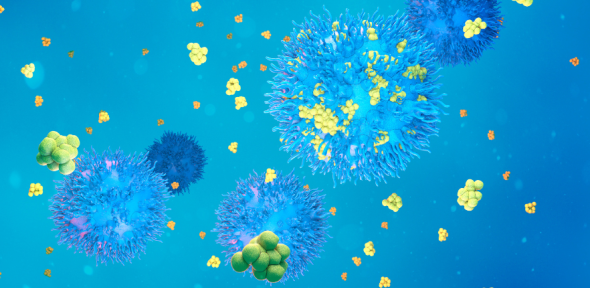
Submitted by Sophie Milbourne on Fri, 24/05/2024 - 13:13
Researchers at the MRC Toxicology Unit have developed a new mouse model for tracking the behaviour of immune cells once an immune response is triggered. This could help scientists to understand how our immune system responds to different insults in more detail to develop new and improved immune therapies.
Our body triggers an immune response when it encounters an antigen. This is something that our immune system doesn’t recognise as ‘self’ or from our body, and could be a virus or bacteria, cancer or even a vaccine.
When an antigen is flagged, a signal is sent to an immune cell called a T cell. These start to multiply in number and divide up into specialised groups to deliver an effective immune response. Some will be responsible for destroying the cells that display the antigen (effector T cells), whereas others will need to memorise this antigen for the future (memory T cells) so, if we encounter it again, our immune system can jump into action more quickly.
Being able to modulate and tweak these important steps that kickstart an immune response is crucial for improving, or developing new, immunotherapies. However, currently we don’t have a way of tracking immune responses after they receive the initial trigger.
Published today in Science Immunology, researchers from the Thaventhiran lab at the MRC Toxicology Unit reported a new mouse model that enables them to gain more detailed insights into such immune responses.
“Tracking immune responses like where the immune cells go, what state they differentiate into or how much they multiply are all vital for really understanding how our immune system works” shares co-first author on this paper, Munetomo Takahashi. “This can tell us where and when an immune response is being generated, and whether there are sufficient effector or memory T cells being produced. All really insightful information that can inform immunotherapy developments or help us to answer clinically relevant questions such as how tumours can evade our immune system”.
In this study, the researchers used this model to determine the behaviour of T cells involved with the tumour immune response. In the model, once T cells receive an antigen signal, they and any of their progeny fluoresce yellow so can be tracked.
Using their model, the group were able to show how the effector subgroup of T cells become trapped within the tumour, continue to grow in number but eventually become exhausted and, as a result, are unable to perform their usual function. Details that have only become unveiled due to this new tool. Additionally, the team report how another subgroup called regulatory T cells were able to escape the tumour site. This new mouse model is not just able to track immune cells as a whole once an immune response has been triggered but allows researchers to distinguish between different groups of immune cells and gain an even more detailed understanding of immune cell behaviour.
Dr James Thaventhiran, Group Leader at the Unit and senior author of this study, said: “The system tracks immunity in a new way and could teach us how to better harness immunity to treat infection, autoimmunity and cancer.”
‘Intratumoural antigen-signalling traps CD8+ T cells to confine exhaustion to the tumour site’ was published in the journal Science Immunology on 24th May 2024. Read the full publication here.


